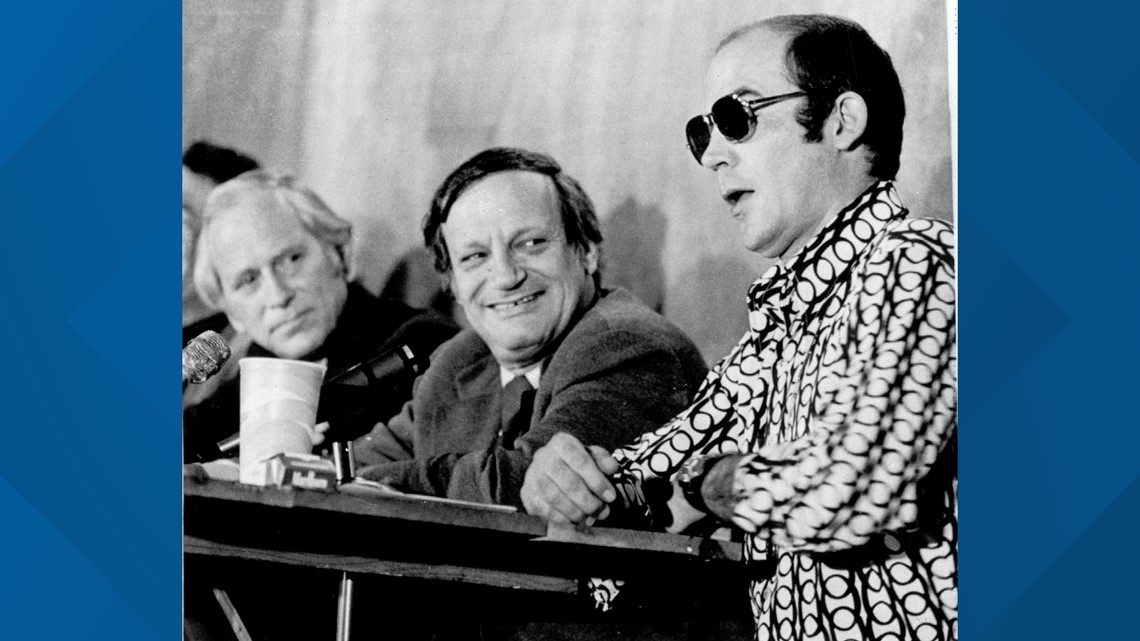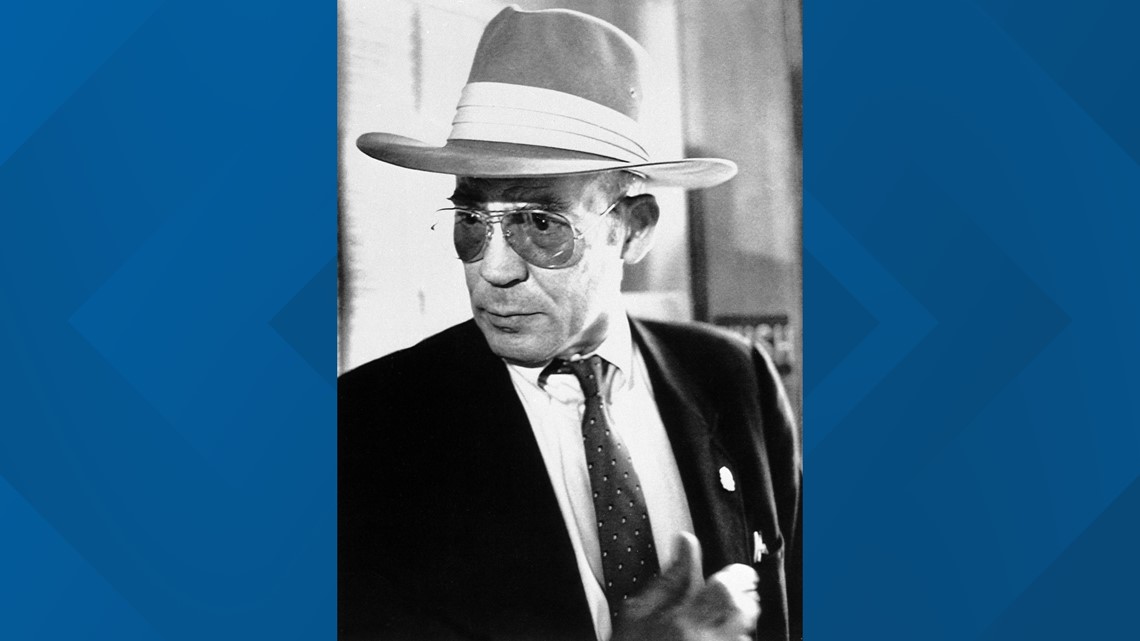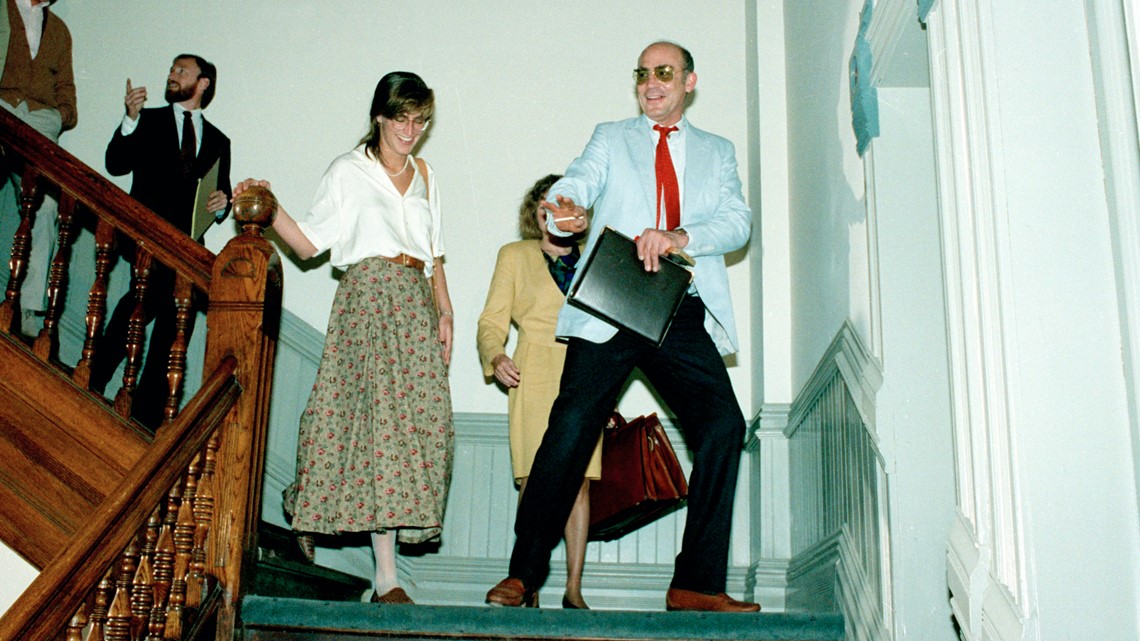ASPEN, Colo. — An old film canister labeled “Hunter Thompson for Sheriff” turned up in artist Travis Fulton’s barn off Ute Avenue in Aspen three years ago, setting off a series of archival discoveries that have shed new light on the gonzo journalist’s influential 1970 campaign and led to the new documentary “Freak Power: The Ballot or the Bomb.”
The film, co-directed by Aspenites Ajax Phillips and Daniel Joseph Watkins, will be released to video-on-demand services Oct. 23.
In all, the filmmakers found about seven hours of film footage shot during the campaign by Robert E. Fulton III. It had never been seen by the public — some of it never developed — and was spread between his archives in Aspen, New Jersey and Los Angeles.
“It’s been a treasure hunt,” Phillips said during a July 2019 editing session.
This story is powered by COLab, the Colorado News Collaborative. 9NEWS joined this historic collaboration with more than 40 other newsrooms across Colorado to better serve the public.
The revelatory footage — along with photographs by David Hiser and Bob Krueger — brings the viewer inside Thompson’s campaign headquarters at the Hotel Jerome, into the legendary debate between Thompson and incumbent Sheriff Carrol D. Whitmire and out to Thompson’s Owl Farm as threats of violence against him mount. It vividly captures the Nixon era scene on the streets as Thompson leads a youthful, peaceful revolution to get young hippies and “freaks” to vote and take control of local government.
“It seems to me the way to cope with power is not to ignore it but to get it,” Thompson says of his aims in the film.
INSIDE THE CAMPAIGN
The film opens with a scene of young Aspenites pouring into the Isis Theatre in downtown Aspen for the 1970 Thompson-Whitmire debate. Onstage, Whitmire claims not to understand what “freak power” is, while Thompson proudly brandishes the label.
“I am not at all embarrassed to be called a freak,” Thompson says. “To deviate from the style of government that I deplore today is not only wise but necessary.”
From there “Freak Power” is off and running, moving at a breakneck pace through Election Night.
A quick-cut montage sets the local and national scene of 1970 — war in Vietnam, assassinations, President Richard Nixon and J. Edgar Hoover, political violence from the Weathermen, racial inequality and activism, student protesters killed at Kent State. It’s cut against the dawn of the drop-out ski bum era in Aspen, when hippies fled cities for the Roaring Fork Valley and clashed with the conservative tourism industry establishment epitomized by Whitmire.
Thompson, radicalized by the police brutality he witnessed and fell victim to while covering the Democratic National Convention in 1968, sought to try a new kind of politics and law enforcement here in his backyard, in the hopes of inspiring national change — a voter-driven revolution that could be duplicated elsewhere around the U.S.
“What we’re trying to do is to make the vote work, to bring people back into the government,” Thompson’s campaign manager Ed Bastian says in archival footage.
Police harassment of hippies and “land rape” by developers were local signals of troubling national trends, Thompson notes.
“I don’t think we can afford to ignore the national political realities any longer,” he says.


“Freak Power” offers a play-by-play of the campaign as it happens from Thompson, Bastian and “minister of information” Alex Sweetman, explaining the Freak Power philosophy and strategy. The film also shows up close the campaign’s fear and paranoia as the opposition begins to play dirty, death threats roll in and the FBI starts spying on the Thompson campaign.
The film cogently explains Thompson’s flamboyant platform to change the name of Aspen to “Fat City,” sod the streets and ban traffic from downtown, control drug sales and forbid nonresidents from hunting and fishing. But it also outlines the more serious and prescient reforms he pushed for, like disarming sheriff’s deputies and down-zoning construction to save the local landscape from development.
The film makes pointed use of footage from prominent Aspenites of the day who criticize Thompson, Mayor Eve Homeyer and the notorious anti-hippie restaurateur Guido Mayer among them. It also suggests that the population of Austrian and German immigrants who had helped found the ski resort here in the 1940s included former Nazis whose intolerance had pervaded local government and politics by 1970.
The issues at the center of the campaign, as captured in “Freak Power,” are shockingly relevant 50 years later. Scenes of voter suppression and post-Kent State protests are strikingly similar to those playing out today nationally during early voting and at Black Lives Matter demonstrations. The viewer is often reminded of how little has changed, but also of how ahead of their time Thompson’s proposed solutions were, including police reform with oversight by an ombudsman, a “community policing” model that finally gained mainstream national traction this summer amid the nationwide protests over police brutality.
Here we see Thompson call for “preventative work” by police, arguing “unless you get at the cause you are never going to control the effect.”
People scoff in the film at Thompson’s drug decriminalization platform, but viewers will notice some of those proposals have became reality in the 21st century, as well.
The film will help solidify Thompson’s legacy as a serious and wise political thinker. The man at the center of “Freak Power” is not the drug-gobbling cartoonish character of “Fear and Loathing in Las Vegas” but a clear-eyed, committed and imaginative reformer (with, of course, a genius sense of humor and flair for political theater, showcased as Thompson shaves his head so he can call Whitmire “my long-haired opponent”).
“Freak Power” races to its conclusion with a gripping tick-tock of the rising tensions and many scandals of the campaign’s final days, including the arrival of an undercover federal agent who attempts to infiltrate the Thompson campaign and the specter of dynamite bombings against the Freak Power faithful.
“Having worked on the campaign, the movie brings out a lot of stuff even I did not know about, especially that paranoia,” former Sheriff Bob Braudis, a volunteer for Thompson in 1970 who went on to become a close friend and to implement many of Thompson’s ideas during his 24 years in office, said Wednesday.
Among the most stunning things in “Freak Power,” Watkins and Phillips noted, is the realization that the iconoclast Hunter Thompson was actually the candidate playing by all the rules in this race, the one using the legal tools of democracy as intended.
“If bombing is the last resort I’m not against it,” he says in the film. “The point is that we are not at that last resort. I don’t think we are anywhere near it.”
The film colorfully captures the heady scene inside the Hotel Jerome on election night, with costumed freaks expecting to usher in a new political era. It also depicts the heartbreak of young Aspen as Whitmire pulls away, winning by 500 votes.
“I made a mistake in thinking the town could handle an honest political campaign,” Thompson says in his concession, wrapped in an American flag and wearing a founding fathers’ wig, adding: “The American Dream really is f---ed.”


MAKING ‘FREAK POWER’
Watkins, director of the itinerant Gonzo Gallery in Aspen, has in recent years aimed to draw national attention to Thompson’s 1970 campaign, which is often overshadowed in pop culture by “Fear and Loathing in Las Vegas” and other Thompson writings. In 2015, Watkins published the book “Freak Power: Hunter S. Thompson’s Campaign for Sheriff” and curated an exhibition of campaign material and ephemera, which has gone on to tour museums across the U.S.
So in 2017 when Travis Fulton found that first canister of campaign film his late brother had left behind, Fulton called Watkins to take a look at the footage.
“We looked at that initial batch and we said, ‘This is amazing,’” Watkins recalled last year.
Watkins had the film digitized, then went searching for more at Fulton’s film archives on both coasts and at Harvard University, where the experimental filmmaker taught after leaving Aspen. Several more canisters of film turned up, most of them with attendant audio tape, which the Aspen team went about syncing.
Looking at it all, it was evident the cache of film offered a revealing and enthralling front-row seat to the iconic 1970 campaign.
“That’s when we said, ‘Well, this is enough for a feature film,’” Watkins recalled.
He and Phillips initially looked for someone else to make it. They showed the footage to filmmakers, including the Oscar-winning documentarian Morgan Neville, and they drew intense interest from Hollywood to make a film using it. But Watkins and Phillips soon concluded they should make it themselves, rather than handing it over to an outsider.
“I encouraged them to be the directors themselves,” said producer Mimi Polk Gitlin, who came on board in 2018. “I encouraged them to do it themselves because they knew the material the best.”
Watkins and Phillips bought exclusive rights to Fulton’s footage from his family and earned financial backing from investors — among them Woody Creekers Rob Pew and Susan Taylor — to pursue the project with creative independence.
Gitlin, whose film credits go back three decades to producing “Thelma & Louise,” provided connections to the industry’s top-tier film and sound editors who would assist the first-time filmmakers in telling Freak Power story.
Angus Wall, the Oscar-winning editor to David Fincher, signed on as a producer and Oscar-winning composer Gustavo Santaolalla wrote the “Freak Power” film score and recorded the original song “Valley of Last Resort” with bluesman Gary Clark Jr. for the end credits.


In April 2019, Watkins and Phillips hunkered down with Aspen-based editor and photographer Tony Prikryl in a cabin off Ute Avenue — adjacent to Travis Fulton’s barn — and started piecing together their film, collecting coverage of the campaign from The Aspen Times to the BBC, sorting through the reams of footage on 12-terabyte hard drives and cutting in new interviews they’d recorded with Bastian, Braudis, Sweetman, County Commissioner Joe Edwards, Rolling Stone founder Jann Wenner and artist Ralph Steadman.
Discussing the footage and the complicated journey of the film with a visitor that summer, Watkins concluded: “You need some reckless optimism and ignorance to do something like this. If I’d known how complicated it was going to be — all the time and the money and Hollywood people and everything — there is no f-ing way I would have done it.”
But he and his team knew they had something special on their hands and continued pressing forward with the goal of landing the film at the 2020 Sundance Film Festival and releasing it publicly before Election Day to inspire young voters.
As it became clear the production schedule wouldn’t get them to Sundance in time, they aimed for a summer 2020 festival launch with expectations of premiering at one of the year’s major film events — Toronto, Venice or Telluride — and finding a distribution deal for theatrical and streaming release.
Then the coronavirus pandemic hit in March and it became clear that the festival season would mostly be canceled. They met with the streamers, studios and broadcasters — from Netflix to Amazon, Apple and HBO — but the prospects of landing there also soured due to COVID-19. They concluded “Freak Power” would remain, perhaps fittingly, a truly independent film and grassroots release.
“Nobody has had the year they wanted to have in 2020,” Phillips said this week. “We had a choice to shelve the film for 12 to 18 months, which is what a lot of movies are doing. But as a team we felt it was important to get this out before the election.”
On Oct. 23, it will go up on Amazon and other video-on-demand services for $19.99.
The film will have its public premiere on Saturday, Oct. 17, in a 60-seat socially distanced setup on the rooftop of the Aspen Art Museum. The event sold out shortly after it was made public Wednesday.
“Our movie premiere is sold out, what more could we ask for?” Watkins said semi-sarcastically, giving Phillips an enthusiastic high-five, when he got the news Wednesday afternoon.
That intimate event will conclude “Freak Power Day” festivities in Aspen, which are scheduled to include a proclamation by Mayor Torre at the Pitkin County Courthouse to temporarily rename the town “Fat City,” a sodding of Hyman Avenue in front of the Gonzo Gallery and other hijinks along with a voter registration drive.
For Sheriff Braudis, whose political career began with the 1970 campaign, “Freak Power” is a necessary catalyst to social change in 2020 and an elegant retelling of the movement that reshaped Aspen government forever.
“Watching the film come together from seed to screening, I’m amazed,” Braudis said. “It’s been constantly pervaded with excellence. It is important and it is awesome.”
atravers@aspentimes.com
SUGGESTED VIDEOS: Colorado Guide



